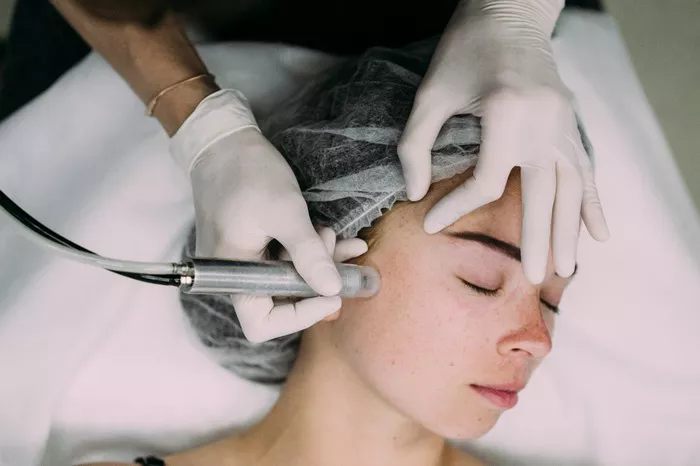Hyperpigmentation is a common skin concern characterized by dark patches or spots caused by the overproduction of melanin. Many individuals seek effective treatments to reduce hyperpigmentation and achieve a more even skin tone. Microdermabrasion is a non-invasive cosmetic procedure that has gained popularity as a potential solution for hyperpigmentation. However, the number of microdermabrasion treatments required to effectively address hyperpigmentation can vary depending on individual skin conditions and the severity of the pigmentation. In this article, we will explore the role of microdermabrasion in treating hyperpigmentation, the factors that influence treatment outcomes, and what to expect during the treatment process.
Understanding Microdermabrasion for Hyperpigmentation
Microdermabrasion is a skin exfoliation technique that uses fine abrasive particles or a diamond-tipped wand to gently remove the outermost layer of dead skin cells. The process stimulates collagen production and promotes skin cell turnover, helping to improve skin texture and tone.
When it comes to hyperpigmentation, microdermabrasion works by exfoliating the surface layer of skin where the excess pigment resides. As the pigmented cells are shed, the skin’s appearance becomes more even and brighter, reducing the appearance of dark spots.
Determining the Number of Treatments
The number of microdermabrasion treatments required for hyperpigmentation varies based on several factors, including:
a. Severity of Hyperpigmentation: Mild cases of hyperpigmentation may require fewer treatments compared to more severe or stubborn pigmentation issues.
b. Skin Type: Different skin types react differently to treatments. Individuals with sensitive skin may require a gentler approach, while those with thicker skin may need more aggressive treatments.
c. Individual Response: Each individual’s skin responds uniquely to microdermabrasion. Some may see significant improvement after a few sessions, while others may need more treatments to achieve the desired results.
d. Depth of Pigmentation: The depth of hyperpigmentation in the skin can influence the number of treatments needed. Deeper pigmentation may require more sessions for noticeable improvement.
e. Maintenance and Sun Protection: Proper sun protection and skincare maintenance between treatments can also impact the effectiveness of microdermabrasion for hyperpigmentation.
Recommended Treatment Schedule
Microdermabrasion treatments are typically spaced a few weeks apart to allow the skin to heal between sessions. A common treatment schedule for hyperpigmentation is an initial series of six to eight sessions, scheduled at two to four-week intervals. However, the specific treatment plan will be determined by the skincare professional based on individual needs and response to the procedure.
What to Expect During the Treatment
Microdermabrasion for hyperpigmentation is a quick and comfortable procedure that can usually be completed in 30 to 60 minutes. During the treatment:
a. The skin is cleansed to remove any makeup or impurities.
b. The handheld device with an abrasive tip is used to exfoliate the skin gently. The intensity of the exfoliation may be adjusted based on the individual’s skin type and pigmentation concerns.
c. After the treatment, a soothing moisturizer and sunscreen are applied to protect the skin and promote healing.
d. There is little to no downtime following microdermabrasion, and individuals can resume their normal activities immediately.
Results and Expected Improvements
After the initial series of treatments, many individuals notice a significant reduction in hyperpigmentation and an overall improvement in skin tone and texture. However, the extent of improvement varies based on the factors mentioned earlier. Some individuals may achieve their desired results after the initial treatment series, while others may opt for periodic maintenance sessions to sustain the benefits.
Complementary Skincare
To enhance the results of microdermabrasion for hyperpigmentation, it is essential to practice a comprehensive skincare routine:
a. Sun Protection: Regularly applying a broad-spectrum sunscreen with SPF 30 or higher is crucial to protect the skin from harmful UV rays, which can worsen hyperpigmentation.
b. Brightening Products: Incorporating skincare products containing ingredients like vitamin C, kojic acid, or niacinamide can help to further reduce hyperpigmentation and promote a more even skin tone.
c. Avoiding Irritants: Refrain from using harsh or irritating skincare products that could exacerbate hyperpigmentation.
Professional Guidance and Consultation
It is essential to consult with a skincare professional or dermatologist before undergoing microdermabrasion for hyperpigmentation. They will assess the individual’s skin condition,determine the appropriate treatment plan, and provide personalized advice on skincare maintenance.
Conclusion
Microdermabrasion is an effective and non-invasive treatment for reducing hyperpigmentation and achieving a more even skin tone. The number of microdermabrasion treatments required to address hyperpigmentation varies depending on individual factors such as skin type, pigmentation severity, and individual response to the treatment. An initial series of six to eight sessions, spaced a few weeks apart, is commonly recommended for optimal results. Regular sun protection and a well-rounded skincare routine can further enhance the benefits of microdermabrasion for hyperpigmentation. Consulting with a skincare professional is essential to develop a tailored treatment plan and achieve the best possible outcomes in the journey towards a brighter and more radiant complexion.

